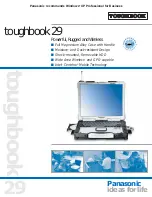
• 10 •
GENERAL CHARGING NOTES
• The large chassis-mounted main fan runs as needed, based on temperatures of the individual charging
boards within the unit and the total power being supplied by the unit. The board-mounted fans run based
on the corresponding board temperature.
• If the charge mode is changed after charging has started (by pressing the Battery Voltage or Battery Type
button), the charging process stops and begins again automatically at the new selection.
• The voltage displayed during charging is the charging voltage and usually will be higher than the
battery’s resting voltage.
POWER CONTROL
To keep the unit from exceeding its input current level specification of 15 A, all charging stations are
connected by an I
2
C (pronounced “i squared c”) communication bus, and power data is accumulated by
one station communicating with all other stations. If the power is greater than 850 W (this corresponds to an
input AC current of about 15 A), the max current of all stations is reduced from 12 A to 7 A. After 2 minutes,
if the total power is still above the 850 W, the max current of all stations is reduced to 4 A. Then, after
two more minutes, if the power persists above 850 W, all stations are turned off. After any of these power
reductions, excluding shut down, if the total power drops below 600 W for 1 hour, the max current in all
stations is then increased back to 12 A.
12. USING THE VOLTMETER TO TEST BATTERY STATE OF CHARGE
OVERVIEW
The charger has a built in voltmeter to test your battery’s state of charge. The charger does not have
a built in load tester. As such, a recently charged battery could have a temporarily high voltage due to
what is known as “surface charge”. The voltage of such a battery will eventually drop during the period
immediately after the charging system is disengaged. Consequently, the tester could display inconsistent
values for such a battery. For a more accurate reading, the surface charge should be removed by
temporarily creating a load on the battery by turning on the lights or other accessories.
The battery tester is only designed to test 6V and 12V batteries. Testing a device with a rapidly changing
voltage could yield unexpected or inaccurate results.
TESTING SEQUENCE
There are three basic steps required to test the battery state of charge:
1. Connect the battery charger’s clips to the battery. Be sure to follow all of the precautions listed under
sections 6 and 7.
2. Connect the charger’s power cord to a 120 VAC outlet. Again, be sure to follow all of the precautions
listed under sections 6 and 7.
3. Read the voltage on the digital meter or press the Display Mode button to set the tester to Battery %
and read the battery percentage.
TESTER AND CHARGER
When first turned on, the charger operates only as a tester, not as a charger. To continue to use it as only a
tester, avoid pressing the START/STOP button. The charger is always in tester mode until the START/STOP
button is pressed. Pressing the START/STOP button activates the charger and deactivates the tester.
TESTING AFTER CHARGING
After the unit has been changed from tester to charger (by pressing the START/STOP button), it remains
a charger as long as it’s connected to a battery. Press the START/STOP button again to change back to
tester mode.











































